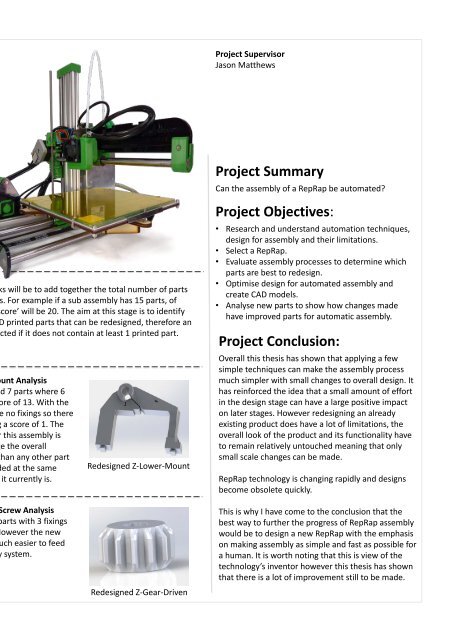UWE Bristol Engineering showcase 2015
You also want an ePaper? Increase the reach of your titles
YUMPU automatically turns print PDFs into web optimized ePapers that Google loves.
Sean Thomas<br />
Mechanical <strong>Engineering</strong><br />
Project Supervisor<br />
Jason Matthews<br />
RepRap Assembly Automation<br />
The design that will be analysed is the Ormerod 2. It was released on 11th September 2014.<br />
This particular RepRap has been selected because it was the newest design and there was<br />
access to one which made understanding how it worked much easier.<br />
Each sub-assembly will be analysed using a formalised ‘scoring’ system. The<br />
goal of this system is to give an indication of how easy it is to automate the<br />
assembly with the parts in their current forms. The parts which will be<br />
redesigned will be within the assemblies which are already most suited to<br />
automation, this structure for selecting sub-assemblies will result in<br />
assemblies with less parts and fewer fixings meaning that each one will take<br />
less time so more can be redesigned.<br />
Original Z-Lower-Mount analysis<br />
This assembly has 7 parts of which 6 are<br />
fixings. This gives a score of 13.<br />
There is 1 printed part with all the fixings<br />
being attached from the same direction,<br />
meaning this is a bottom-up assembly.<br />
The printed part has no symmetry but its<br />
shape would make it easy to create a rig<br />
where the part will only fit in the correct<br />
orientation.<br />
Original Z-Lower-Mount<br />
The way this system works will be to add together the total number of parts<br />
and the number of fixings. For example if a sub assembly has 15 parts, of<br />
which 5 are fixings, the ‘score’ will be 20. The aim at this stage is to identify<br />
assemblies which have 3D printed parts that can be redesigned, therefore an<br />
assembly will not be selected if it does not contain at least 1 printed part.<br />
Redesigned Z-Lower-Mount Analysis<br />
The original assembly had 7 parts where 6<br />
are fixings this gives a score of 13. With the<br />
redesigned part there are no fixings so there<br />
is just a single part giving a score of 1. The<br />
percentage reduction for this assembly is<br />
92%. This part will change the overall<br />
assembly process more than any other part<br />
because it cannot be added at the same<br />
point in the process that it currently is.<br />
Redesigned Z-Lower-Mount<br />
Project Summary<br />
Can the assembly of a RepRap be automated?<br />
Project Objectives:<br />
• Research and understand automation techniques,<br />
design for assembly and their limitations.<br />
• Select a RepRap.<br />
• Evaluate assembly processes to determine which<br />
parts are best to redesign.<br />
• Optimise design for automated assembly and<br />
create CAD models.<br />
• Analyse new parts to show how changes made<br />
have improved parts for automatic assembly.<br />
Project Conclusion:<br />
Overall this thesis has shown that applying a few<br />
simple techniques can make the assembly process<br />
much simpler with small changes to overall design. It<br />
has reinforced the idea that a small amount of effort<br />
in the design stage can have a large positive impact<br />
on later stages. However redesigning an already<br />
existing product does have a lot of limitations, the<br />
overall look of the product and its functionality have<br />
to remain relatively untouched meaning that only<br />
small scale changes can be made.<br />
RepRap technology is changing rapidly and designs<br />
become obsolete quickly.<br />
Original Z-axis Lead Screw Analysis<br />
This assembly consists of 5 parts where 3<br />
are fixings. This results in a score of 8.<br />
This could be completed as a bottom-up<br />
assembly as there is 1 printed part and 3<br />
nuts which are attached to a rod, if they<br />
are all added from the same end then it<br />
can be assembled bottom-up.<br />
Original Z-Gear-Driven<br />
Redesigned Z-Axis Lead Screw Analysis<br />
This assembly still has 5 parts with 3 fixings<br />
so the score remains 8. However the new<br />
design makes the part much easier to feed<br />
in an automatic assembly system.<br />
Redesigned Z-Gear-Driven<br />
This is why I have come to the conclusion that the<br />
best way to further the progress of RepRap assembly<br />
would be to design a new RepRap with the emphasis<br />
on making assembly as simple and fast as possible for<br />
a human. It is worth noting that this is view of the<br />
technology’s inventor however this thesis has shown<br />
that there is a lot of improvement still to be made.


